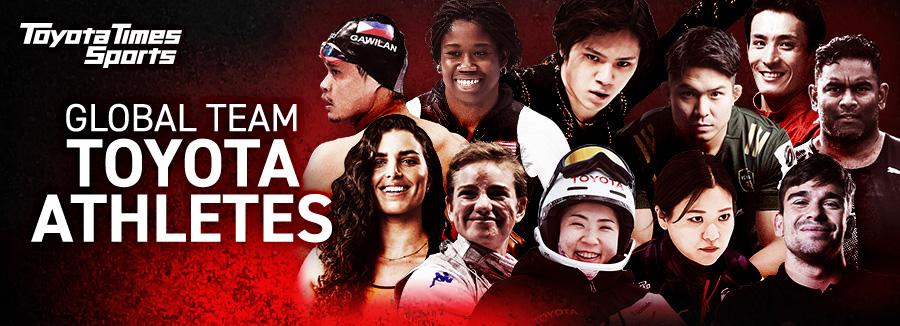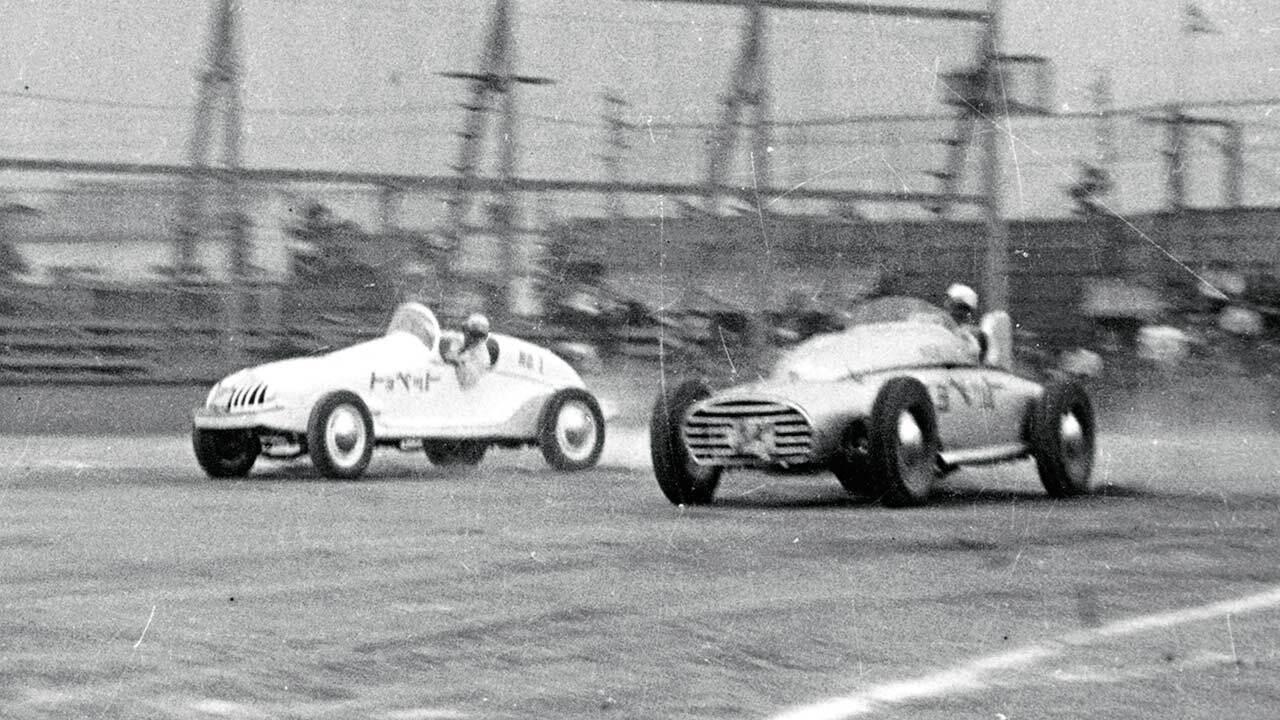
Toyota Times provides a series of articles featuring the project to revive Toyota's first racing car "Toyopet Racer", developed 70 years ago. The first part describes its historical background and Toyota founder Kiichiro Toyoda's passion in developing the car.

This series features Toyota’s project to revive a legendary racing car by reporting on the project members’ efforts as well as the history and meaning behind this vehicle.
Naoaki Nunogaki, Director of the Toyota Automobile Museum and the person overseeing this project, was interviewed for the first article of this series.
The rarely-mentioned passion and spirit of the founder, Kiichiro
You may not have heard of the car known as “Toyopet Racer.” It was the first racing car that Toyota developed and launched in 1951.

Taking part in races to make ever-better cars originates in this vehicle
It has become obvious from a variety of documents that this racing car represents an indispensable part of Toyota’s history packed with the passion of Toyota founder Kiichiro Toyoda (1894-1952).
The spirit of Kiichiro is embodied in this Toyopet Racer. He had a grand plan to pioneer the future of the automobile industry in Japan by taking part in races.
Kiichiro’s passion revealed by historical documents and what his grandson has done in pursuit of making ever-better cars seem to overlap. Akio Toyoda, and Morizo when sitting behind the wheel in taking part in races himself, has been passionate about making ever-better cars based on motorsports.
The legendary racing car
However, very few people have heard of this racing car even within Toyota Motor Corporation. Nunogaki explains why.
“Toyopet Racer is the one and only racing car that Kiichiro Toyoda was involved in developing. But since Toyota was in the midst of the biggest financial crisis in its history in the spring of 1950, Toyota Dealers Association was held responsible for developing this vehicle instead of Toyota Motor Corporation, which was unprecedented. Plus, car racing in Japan was still in its developmental stages, and in a state of chaos. Moreover, Kiichiro met with an untimely death in 1952. I think it was these conditions that led to the topic being kept on the hush.”
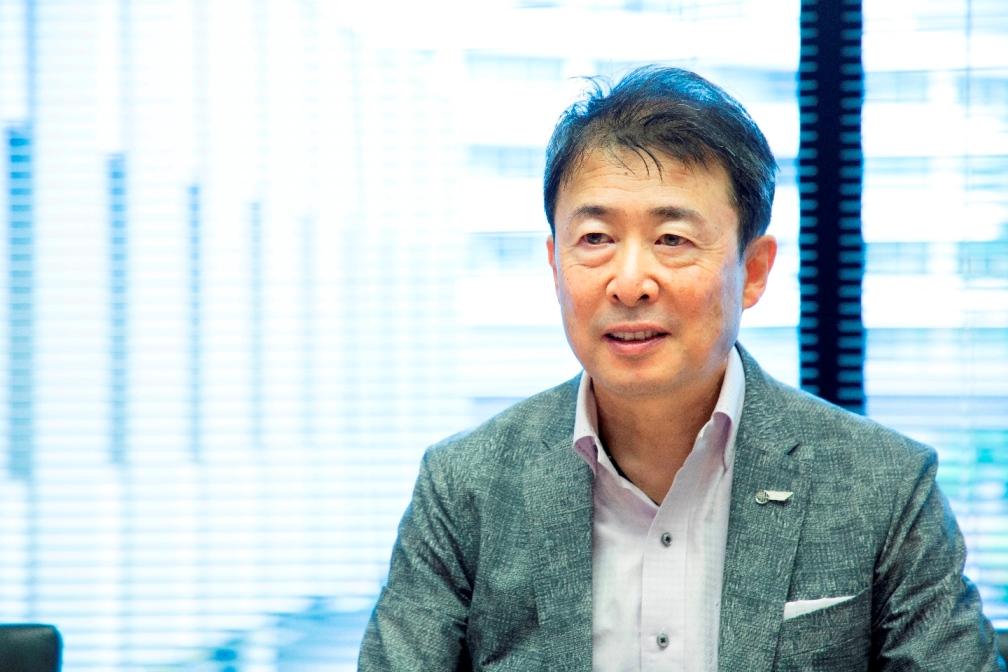
Nunogaki himself was unaware of the existence of this vehicle until he was assigned to his current post in which he deals with the history of the company.
More details on this vehicle and the background behind it can be found in the book, Toyota Motorsports Zenshi – Toyopet Racer, Goshu Isshu Rally-wo Chushin-toshite (Early History of Toyota Motorsports – About Toyopet Racer Centered on the Round Australia Rally) (published by Miki Press in 2018), written by Hideo Matsumoto, who worked for Toyota’s Motorsports Division and the Toyota Automobile Museum, and continued devoting himself to compiling information on the company’s history even after retirement.
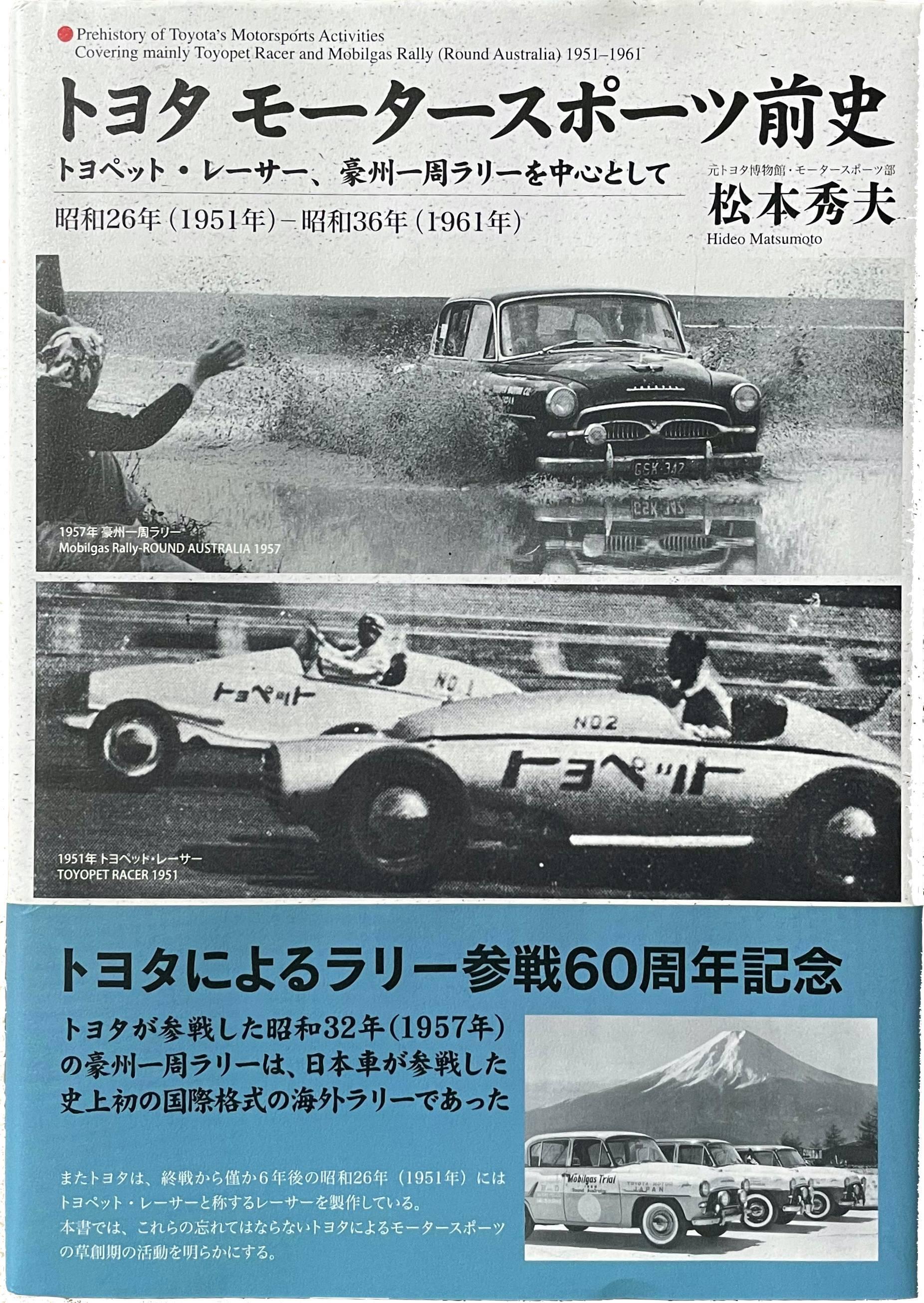
According to this book, the development of this racing car was unveiled to the public for the first time in November 1950. The Sales Division of Toyota Motor Co., Ltd. (hereinafter “Toyota Motor”) was spun off to establish Toyota Motor Sales Co., Ltd. (hereinafter “Toyota Motor Sales”) in April 1950, and the announcement was made in the PR magazine, “All Toyota (November 30 issue),” published by their Marketing Department. In the magazine, they suggest that Toyota take part in auto racing with Toyopet Racer.
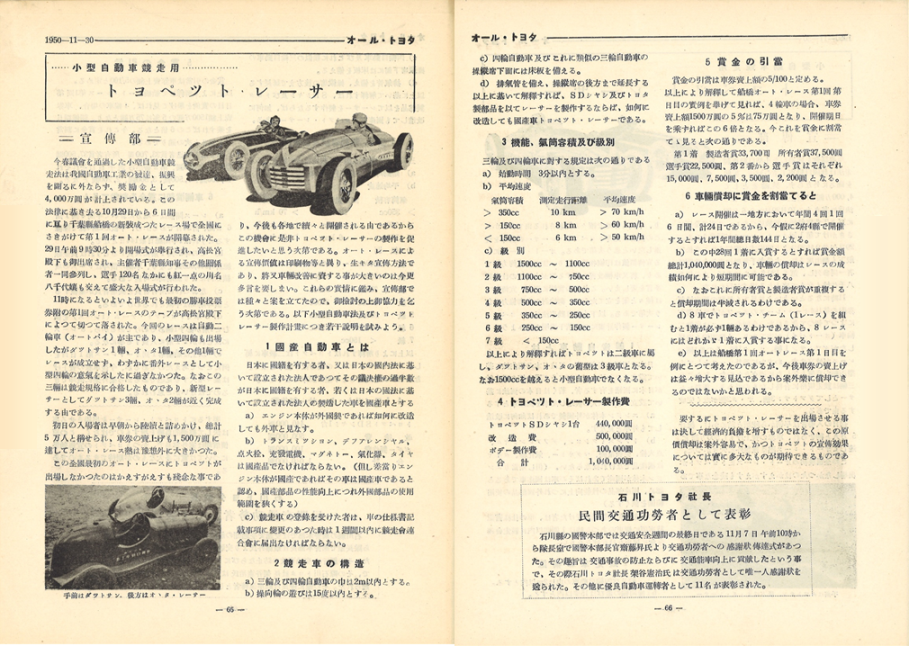
However, Kiichiro Toyoda was no longer at Toyota Motor. He had retired in June that year.
Amid the biggest crisis in Toyota’s history
Toyopet Racer was developed a mere five years after the Second World War had ended. Everything from politics to the economy in Japan at the time was strictly under the control of GHQ (General Headquarters), and a permit had to be obtained from GHQ even to produce cars. It was not until 1948 that companies involved in the automobile industry of Japan, including Toyota, were finally granted full permits to produce cars.
But Japan entered into a major recession immediately after this. GHQ implemented a financial and monetary contraction policy, otherwise known as the Dodge Line, in 1949. Car sales plummeted and automobile manufacturers were faced with an unprecedented financial crisis. Companies had no choice but to lay off workers.
During this crisis in April 1950, Toyota Motor Sales was established to separate manufacturing from sales as a trump card to ride out this crisis. However, Toyota was not exempt from labor disputes that broke out between the company and the labor union. Employees and company management initially agreed not to lay off any workers, but the company was unable to resist the loan syndicate consisting of 24 banks, led by the Bank of Japan, financing the restructuring of the company.
The company made an early retirement offer to cut back on the number of employees. They ultimately worked out a settlement, but Kiichiro Toyoda took responsibility for what had happened and stepped down from his position as President of the company. Some members of even the labor union asserted that there was no need for President Kiichiro to resign, but he stood firm on his decision.
“It’s obvious from an article Kiichiro Toyoda later wrote for the Aichi Toyota PR magazine that the development and production of Toyopet Racer was his own idea. It’s also surprising that he was thinking about taking part in racing during that crisis.
It would have been impossible to make this car at Toyota Motor where he had resigned as President. But Kiichiro had a belief that the future and growth of the Japanese automobile industry was dependent on outstanding compact cars with small, high-output engines that were also fuel efficient. Through doing so, he wanted to close the technological gap with Europe and the U.S. that had opened up as the result of being unable to manufacture cars during and after the war.
This required improvements to be made to the technology through participation in races. He wanted to develop a racing car as soon as possible to take part in races,” says Nunogaki.
To realize his dream, Toyota Motor Sale, instead of Toyota Motor was chosen to develop and produce the racing car. The name Toyopet Racer, and not Toyota Racer, was most likely used to promote the nickname “Toyopet” for Toyota’s cars, which at the time had been chosen from among names submitted after a public appeal for suggestions.
It is also apparent from a letter Kiichiro wrote to Motoharu Kobayakawa that Toyopet Racer was Kiichiro’s idea.

Kobayakawa was Kiichiro’s acquaintance and a pioneer in the world of Japanese motorsports who had been racing as an amateur racer since before the Second World War. It seems Kiichiro had been consulting Kobayakawa for advice on Toyota’s participation in motorsports. The letter contains a passage in which he says, “I think it’s better to get a sales company involved in something like this, rather than leaving it entirely up to a manufacturing company. So, I hope to talk to a sales company too.” This testifies to the fact that Kiichiro Toyoda was the driving force behind the Toyopet Racer project and that it was his own idea.
A chassis and engine taken from Toyopet Model SD
So, what kind of car was this Toyopet Racer that had been built by the engineers of Toyota dealers?
It was based on Toyopet Model SD, launched in 1949, and used mainly as taxis. This was a car with an all-steel passenger-vehicle body and a 995 cc in-line 4-cylinder S-type engine with side-valves generating 27 hp, mounted on a ladder frame developed for Toyopet Model SB Truck, a compact truck launched in 1947.
Toyopet Racer combined this ladder frame and engine with an original body resembling those of European racing cars of the time, developed by the Service Division of Toyota dealers. The No. 1 vehicle was completed by Osaka Toyota in May 1951, and the No. 2 vehicle was built by Aichi Toyota Motor.
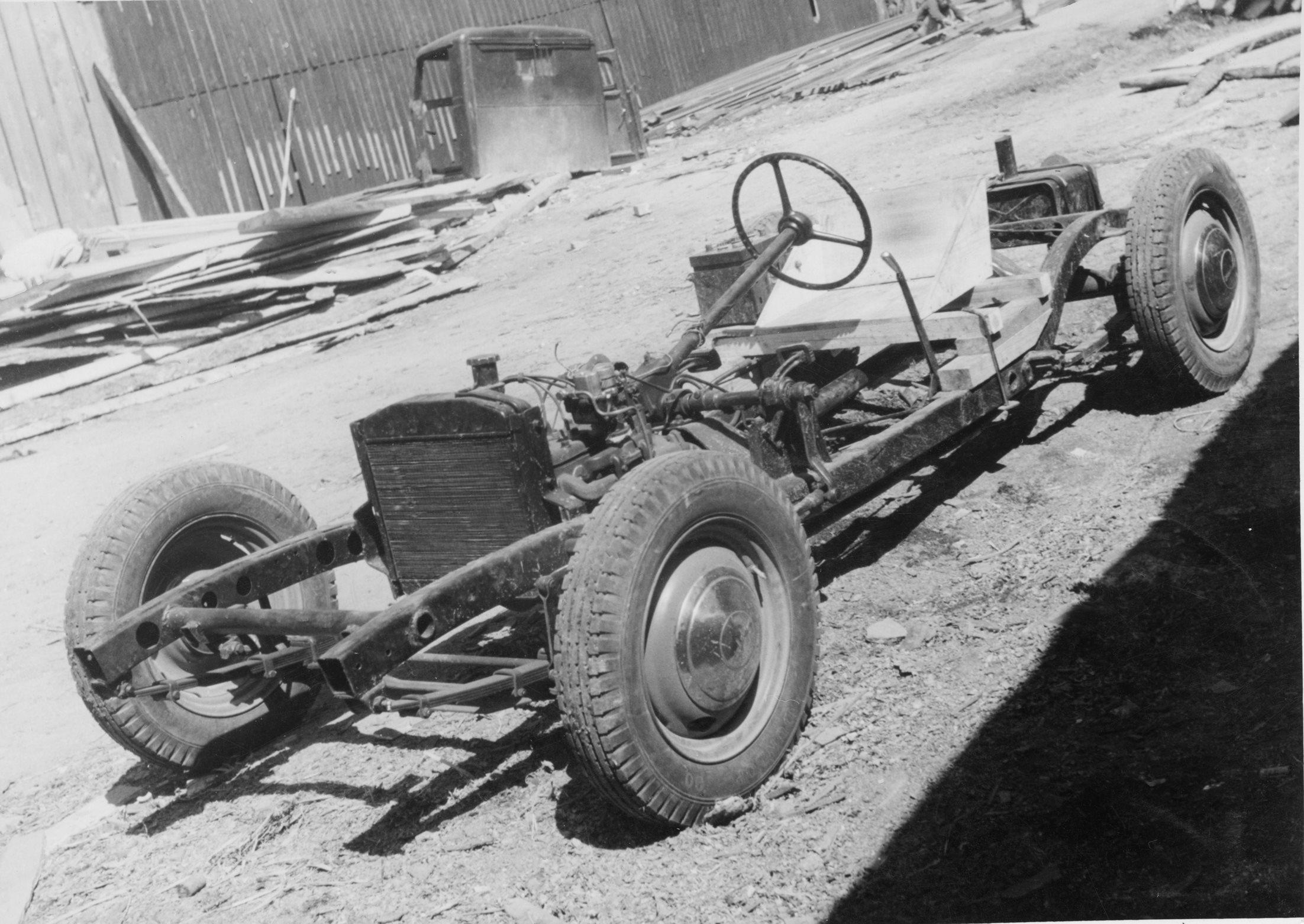
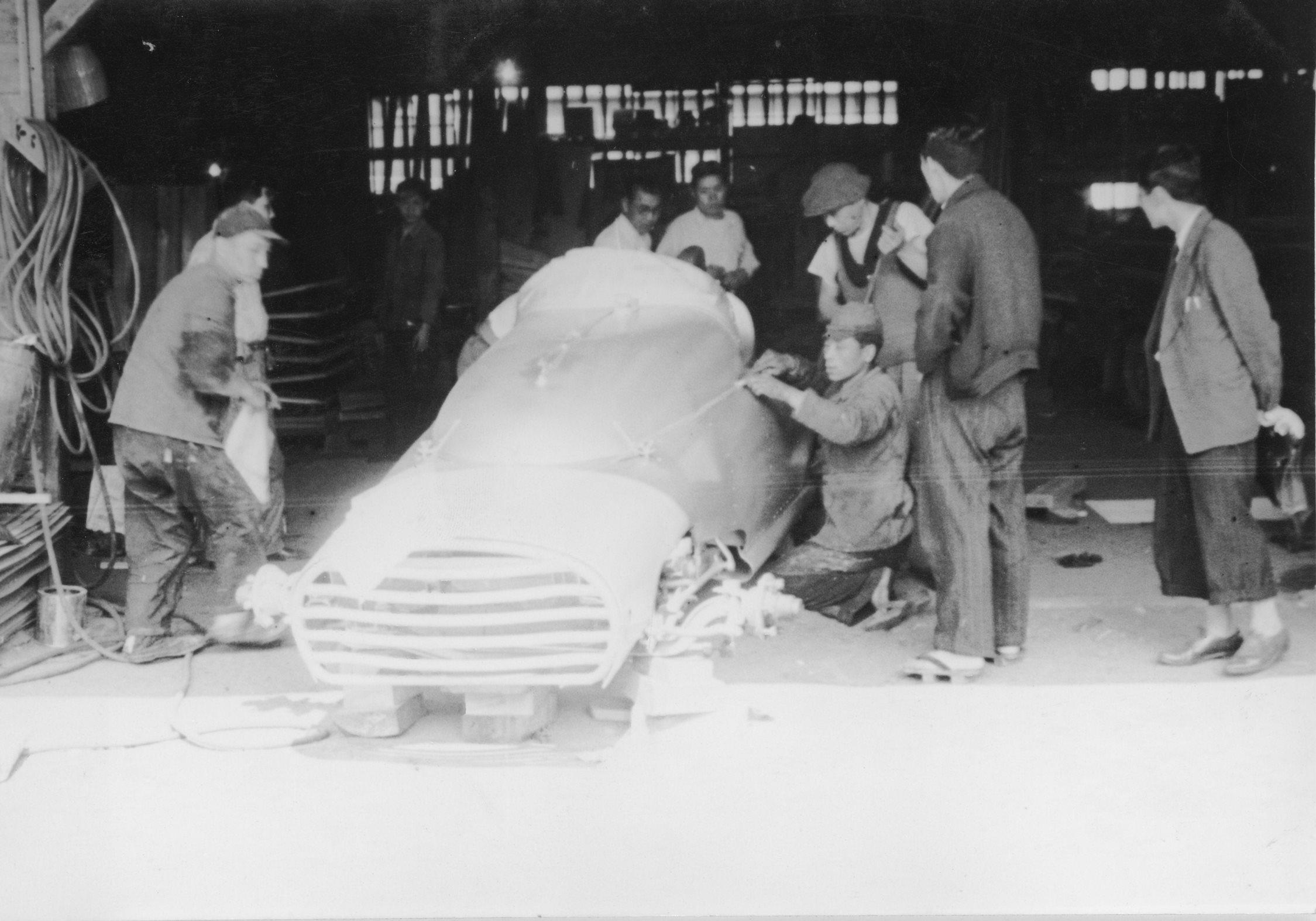
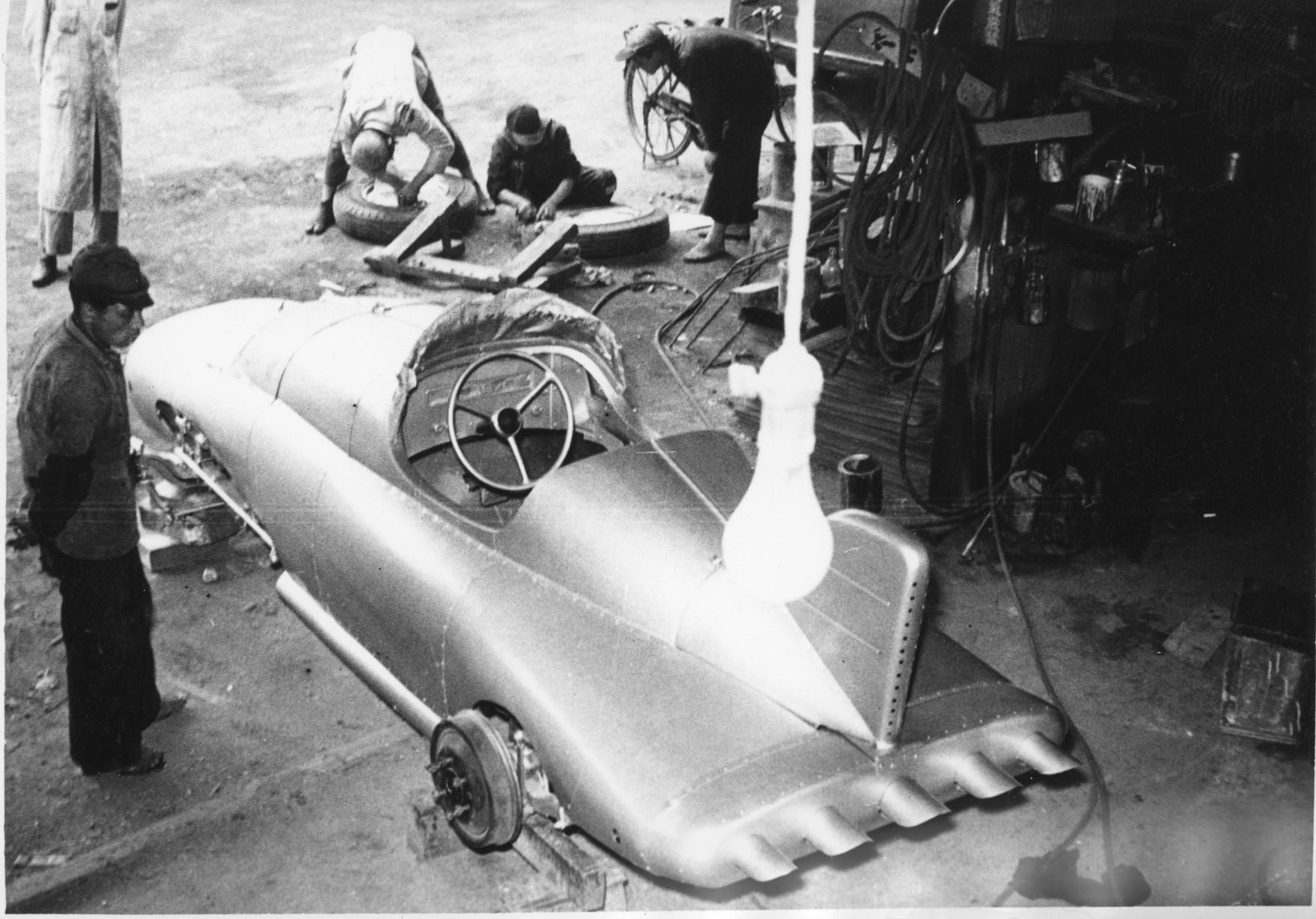
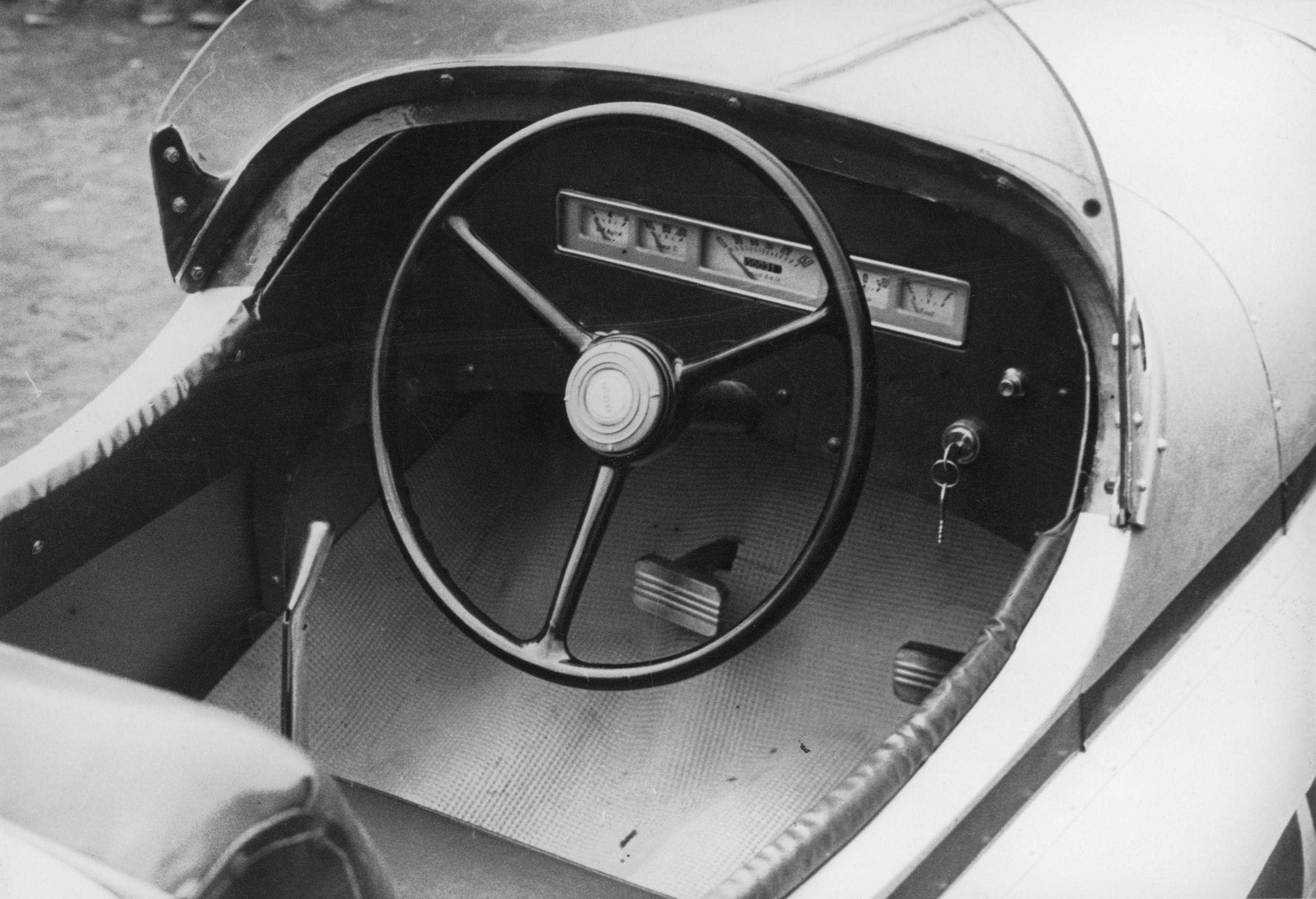
“The body was hand-made and the design was left entirely up to the people working on-site, so the No. 1 and No. 2 vehicles look completely different. There were plans to build six cars at the time, but they only ended up building two,” explains Nunogaki.
Built to take part in auto races
What kind of races did the company have in mind at the time, when these two Toyopet Racers were developed? Answering this question will require a look at the Small Car Racing Law passed by the Diet in 1950.
The bill was submitted to the Diet in March 1950, and it is interesting to note the way it reflects the attitudes of the time toward domestic cars and auto racing.
Its aim was to improve the performance of engines and their bodies by holding races that only domestically-produced motorcycles and cars could take part in, leading to the development of small vehicles that would be exported in the future. In other words, its main objective was to promote the development of domestic vehicles.
However, this law had another purpose, and it was to help finance local governments through municipally-operated gambling, as with bicycle racing, which was highly popular at the time.
Today, everyone knows that motorcycle and powerboat races held for the purpose of gambling, in which everyone uses standardized machines, are completely different from auto racing. But people were not aware of the differences at the time when auto racing was still a minor sport in Japan.
The law was passed by the Diet at the end of May in 1950, and by October, the 1st races were held over six days, mainly by motorcycles, on a track built within the Funabashi Racecourse in Funabashi City of Chiba Prefecture. An exhibition race was also held between Datsun, Ohta and one other vehicle attracting a huge audience.
As it was explained earlier, the development of Toyopet Racer was suggested by the Marketing Department of Toyota Motor Sales in the November 30, 1950, issue of “All Toyota” in response to these activities by Toyota’s competitors.

The Toyopet Racers’ participation in the race was intended to promote sales of Toyopet, the car that the company was selling at the time. In other words, the development and production of Toyopet Racer, and its participation in auto racing were all a part of a strategy to boost sales. The company could recover developmental costs by winning prize money, and it could also benefit from the publicity created by entering the race.
In December 1950, the Marketing Department of Toyota Motor Sales decided to make an all-out effort to build two racing cars to take part in the race to be held in May 1951 at Funabashi. After discussions between the Technology Department and Prototype Section at Toyota Motor, it was decided that Toyopet Racer would be developed and produced by the Service Department of Toyota dealers: Osaka Toyota and Aichi Toyota Motor.
For the future of Japan’s automobile industry
So, how did Kiichiro Toyoda feel about establishing this unprecedented system in developing and producing Toyopet Racer?
There is an interesting passage on this in the book, Toyota Motorsports Zenshi – Toyopet Racer, Goshu Isshu Rally-wo Chushin-toshite (Early History of Toyota Motorsports – About Toyopet Racer Centered on the Round Australia Rally). It describes the talks that were held on March 1, two months before completion of the two Toyopet Racers in May 1951, when Kiichiro attended a directors’ meeting held by the Toyota Dealers Association.
At the meeting, Kiichiro asserted, “I have my reservations about holding auto races for the purpose of gambling, so you don’t have my full approval. But we must take part if the races are going to be based on the premise that only domestically produced cars can enter, and it’s going to help advance Japan’s automobile technologies.” This philosophy was reiterated by him just prior to his untimely passing at the age of 57, on March 27, 1952, in the article, Auto Race-to Kokusan Jidosha Kogyo (Auto Racing and the Domestic Automobile Industry), he wrote for the March issue of Aichi Toyota Motor’s PR magazine, “Aichi Toyota”.
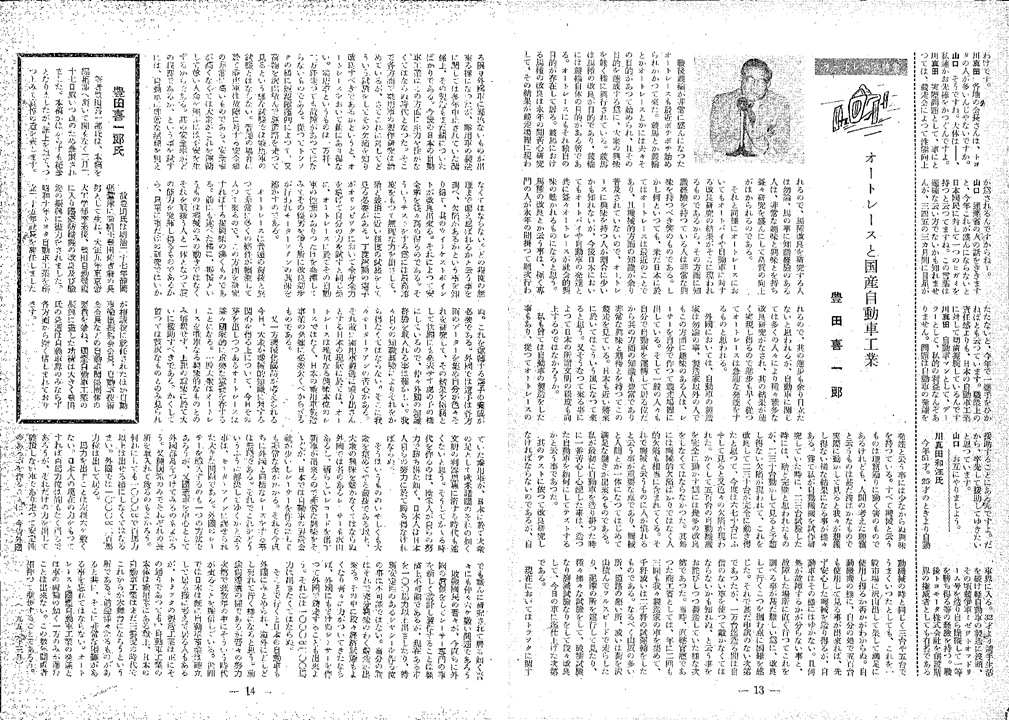
It was a lengthy article, but below is how the article concluded.
As people of a nation that lost the war, it is economically unfeasible for us to try and immediately imitate other overseas countries in designing and building a car built specifically for racing. But we can give current models over 100 hp of output or design a special chassis with great stability, and for the time-being, that would be more than enough to achieve interesting results in races. While doing so, our economy will gradually recover, and if we make steady progress, it will allow us to build racing cars capable of competing overseas. But to do this, we must aim to build engines of at least 1,000 cc with 200 hp.
That’s how Japanese cars will win recognition overseas, and they will begin to sell steadily in other countries. We have a long way to go, but it’s entirely dependent on the effort we put into it, and I am absolutely certain that such a time will eventually come. Some people believe that the automobile industry in Japan is already well-established, and although they may be right in regard to the truck industry, a larger part of the automobile industry revolves around passenger vehicles.
As such, the automobile industry in Japan is still in its developmental stage, and it has yet to blossom into a fully-fledged industry. There may be a bright future for the industry, but we must remember that there are also numerous difficulties that lie ahead.
Auto racing and the domestic automobile industry are like the wheels on both sides of a car; the vehicle cannot move forward with only the wheels on one side of it turning. Over the coming years, the wheels on both sides will turn simultaneously and we will make progress.
This testified to his vision for the future of the Japanese automobile industry in which Japanese manufacturers would build on their technologies through racing, and develop compact, high-performance cars that would rival those of overseas companies leading to their success in overseas markets. In the world of racing too, they would compete on an equal footing with overseas manufacturers.
The development and production of Toyopet Racer, Toyota’s first racing car sharing many of the components of Toyopet Model SD, was the first step toward realizing this vision. Nunogaki decided he wanted to revive this racing car to pass on Kiichiro Toyoda’s spirit to future generations.
“Unfortunately, the Toyopet Racer project to take on the challenges of auto racing failed to achieve any major results. However, the will of the founder of Toyota Motor Corporation to make ever-better cars, represented by the one and only racing car Kiichiro helped to develop, has survived the test of time. It’s been inherited by his grandson, President Akio Toyoda. I felt that the best way to pass on this spirit to future generations was to revive this vehicle,” says Nunogaki.
Launch of the project to revive the vehicle

Nunogaki says he proposed his idea to Akio on October 15, 2018, telling him how he would love to revive the Toyopet Racer.
“President Akio Toyoda regards auto racing to be a place for making ever-better cars, and a part of activities that will contribute to the future of the automobile industry. On May 22 and 23, he himself got behind the steering wheel to enter and complete the “2021 Super Taikyu Series Round 3, Fuji Speedway 24 Hours” in a hydrogen-powered Corolla. This was a realization of the philosophy, which began with the Toyopet Racer. It was also the only racing car that his grandfather was involved in developing. I told him that it was the reason for the dream of reviving this machine,” says Nunogaki.
Akio was quick to show his approval. This was the start of the project to revive Toyopet Racer by Nunogaki and several employees who volunteered to take part.
The first part in this series reported on what Toyopet Racer is all about-the racing car which kicked off Toyota’s participation in auto racing with the aim of making ever-better cars. The next part will report on the revival project in depth.
(Text: Yasuhito Shibuya)
Naoaki Nunogaki
Nunogaki was involved in the development of the 1st-generation Harrier, Altezza and ist as Chief Designer. In 2006, he became General Manager of Global Design Planning Division, where he was in charge of Toyota’s overall design strategy and branding. He has been working as Director of the Toyota Automobile Museum since 2014, and since January 2020, he is General Manager of Corporate Citizenship Division.

